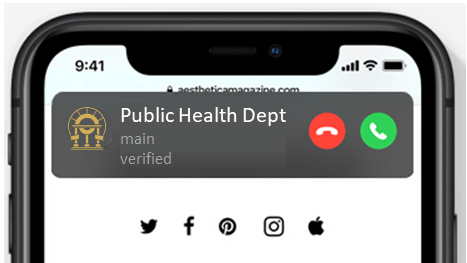Spam robocalls hinder Covid-19 contact tracing efforts
CNN reporter Faith Karimi wrote an article about Covid-19 contact tracers and their struggle to get people to answer the phone. Subscribers are wary of spam robocalls and are reluctant to answer calls from a number they don’t recognize. Solutions are available, but not yet widely deployed. Let’s have a look.
Covid-19 contact tracing
When a person tests positive for Covid-19, healthcare officials will ask the patient who they’ve been in contact with over the previous week or two. Contact tracers will then try to call these people, encourage them to get tested for Covid-19 and limit contact with others until they get the test results.
Contact tracing obstacles
Contact tracing phone call answer rates listed in the CNN article range from 90-95% in Cuyahoga County, Ohio, to 60% in Northwest Georgia. Here are the obstacles these callers face:
- Subscribers have been worn down by scam robocalls and hesitate to answer calls from unknown numbers.
- Contact tracers call from telephone numbers with caller display name to identify them as the department of health. However, cellphones usually show the calling telephone number, not the caller display name, unless the subscriber has enrolled in a premium service from their wireless carrier or is using a special app on their phone.
- CNAM (caller name) databases are not always updated promptly.

Solutions are available, but not yet widely used
Here are solutions that would improve call completion.
STIR/SHAKEN call authentication
Some voice service providers large and small have begun deploying this call authentication technology in their telephone networks. As it becomes more widely used, STIR/SHAKEN can be used to inform the called party that the caller ID was verified. This gives the subscriber confidence that the number wasn’t spoofed, and the call probably is not a spam robocall.
Rich Call Data

Rich Call Data builds on the STIR/SHAKEN framework to provide additional information about the caller, such as a caller display name. Unlike CNAM, Rich Call Data is maintained by the calling organization and the originating service provider that authenticates the call using STIR/SHAKEN. Rich Call Data avoids the pitfalls associated with CNAM. Rich Call Data is up to date and on brand.
It seems clear that contact tracers would have more successful call attempts with a caller display like this, showing the health department caller name, their logo, and SHAKEN verification status of verified (note: this is an illustrative example).
TransNexus solutions
We offer STIR/SHAKEN, including Rich Call Data features, and robocall prevention solutions in our ClearIP and NexOSS software platforms. Contact us today to learn more about these solutions.
Our STIR/SHAKEN products:
- Work with your existing network
- Support SIP and TDM
- Affordable, easy to deploy